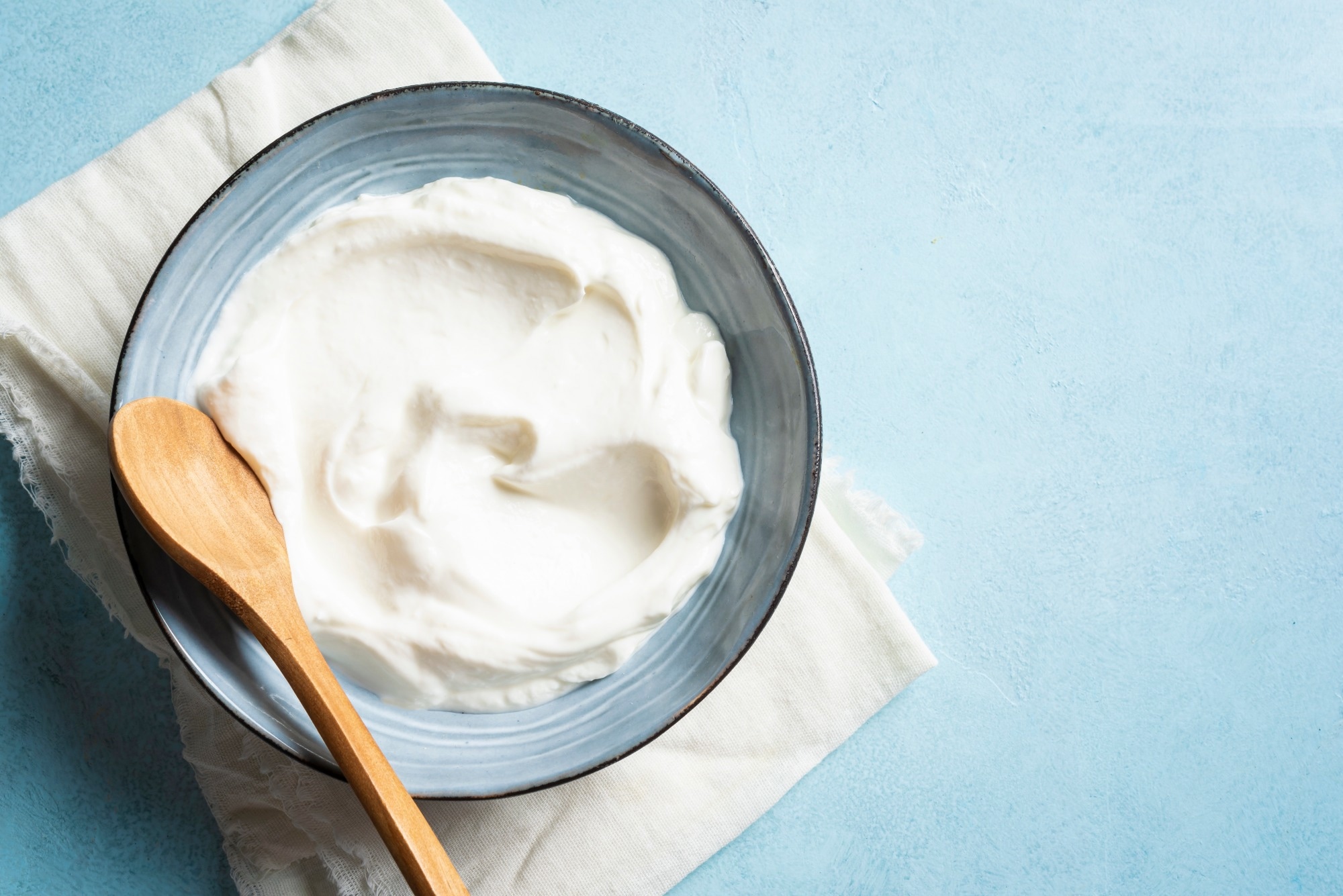Researchers found that younger males who ate Greek yogurt after coaching confirmed decrease ranges of irritation than those that consumed a carb pudding, highlighting the ability of fermented dairy in restoration.
 Research: Resistance Train Coaching and Greek Yogurt Consumption Modulate Markers of Systemic Irritation in Wholesome Younger Males—A Secondary Evaluation of a Randomized Managed Trial. Picture credit score: Oksana Mizina/Shutterstock.com
Research: Resistance Train Coaching and Greek Yogurt Consumption Modulate Markers of Systemic Irritation in Wholesome Younger Males—A Secondary Evaluation of a Randomized Managed Trial. Picture credit score: Oksana Mizina/Shutterstock.com
A current research in Vitamins used an isoenergetic carbohydrate pudding (CP) management to evaluate the consequences of post-exercise Greek yoghurt (GY) consumption on markers of systemic irritation throughout an train coaching intervention.
Train, dietary supplementation, and anti inflammatory markers
Publish-exercise vitamin performs a key function in restoration and maximizing the advantages of coaching. Lengthy-term train coaching lowers inflammatory cytokines equivalent to tumor necrosis factor-alpha (TNF-α) and interleukin (IL)-6, though acute bouts can quickly increase them. The kind of vitamin consumed after exercises could amplify these advantages.
Dairy merchandise are glorious post-exercise dietary supplements on account of their carbohydrate, protein, and electrolyte content material. In addition they have anti-inflammatory and anti-oxidative constituents and have been linked to decrease irritation markers like C-reactive protein (CRP).
Analysis has extensively studied milk, however given the widespread consumption of yoghurt, it might be worthwhile learning its results as a supply of post-exercise vitamin. That is significantly true for GY, given its extra bioactive parts, increased protein content material than milk, and fermented nature. This may increasingly decrease nuclear issue kappa B (NF-kB) exercise and alter the intestine microbiome, reducing circulating inflammatory cytokines. Moreover, analysis has but to analyze the short- and long-term results of GY consumption and train coaching.
Concerning the research
This research used an isoenergetic CP management to evaluate the short-term (1 week) and long-term (12-week) results of progressive resistance train coaching and GY supplementation on markers of systemic irritation (CRP, IL-1 beta [IL-1β], TNF-α, IL-6, IL-10, and IL-1 receptor antagonist (IL-1ra)). The impact of a change in physique composition on inflammatory markers after a exercise was additionally analyzed.
The participant pattern comprised 30 wholesome Canadian males aged between 18 and 25, randomly assigned to both the GY or CP group. They carried out resistance train coaching occasionally, had regular physique fats percentages, and had not taken dietary dietary supplements within the final six months. Throughout the intervention, each teams underwent high-intensity, high-impact resistance and plyometric train coaching thrice per week for twelve weeks.
On coaching days, the GY group acquired 200 g of 0% fats yoghurt supplementation thrice a day. On non-training days, the amount was diminished to 150 g twice day by day. The CP group was given 47g of CP made in-house. Venous blood samples have been collected at baseline, week 1, and week 12 of the intervention.
Research findings
Concerning common day by day dietary consumption, each teams elevated their day by day magnesium, potassium, and vitality consumption. By week 12, the GY group consumed extra protein, calcium, and phosphorus than the CP group. The concentrations of IL-1ra and CRP elevated at week 1 in contrast with baseline, and IL-1ra remained elevated at week 12 in contrast with baseline, whereas CRP returned nearer to baseline.
Relative to the baseline, the concentrations of IL-1β at weeks 1 and 12 have been decrease. The focus of IL-6, relative to baseline and week 1, was decrease at week 12 within the GY group, however not within the CP group. The week 12 TNF-α focus and the TNF-α ratio to IL-10 elevated in CP however not GY.
Linear regressions have been estimated to gauge the change in every inflammatory marker. Throughout the intervention interval, higher decreases in IL-1ra and IL-1β have been predicted by increased baseline ranges of IL-1ra and IL-1β, respectively. Over the intervention interval, a higher enhance in fats mass predicted a lower in IL-1β. GY predicted a discount in IL-6, in comparison with CP. Moreover, a rise in IL-6 over the intervention interval was indicated by a rise in fat-free mass.
The change in TNF-α predicted will increase in IL-10 over the intervention, whereas the baseline focus of IL-10 predicted decreases. It was additionally famous that GY predicted a rise in IL-10 (a non-significant pattern, p = 0.081) and a lower in TNF-α, in comparison with CP. A higher discount in CRP was predicted for people with the next baseline focus of CRP. Lastly, a rise in IL-10 predicted an increase in TNF-α.
Conclusions
Train coaching offered anti-inflammatory advantages, notably lowering IL-1β and exhibiting a short-term enhance at week 1 that returned to baseline by week 12. Consumption of GY enhanced these advantages by reducing IL-6 and stopping will increase in TNF-α and the TNF-α/IL-10 ratio seen in CP. Sooner or later, extra analysis needs to be carried out to know the important thing predictors of adjustments in inflammatory markers, along with train and vitamin.
A key limitation of the research is the lack to detect variations between the CP and GY teams for the reason that research was not primarily designed to analyze systemic irritation. Moreover, the generalizability of the findings to different populations can’t be established as a result of the research individuals have been all younger, wholesome, and lean people with out increased resting ranges of irritation.

